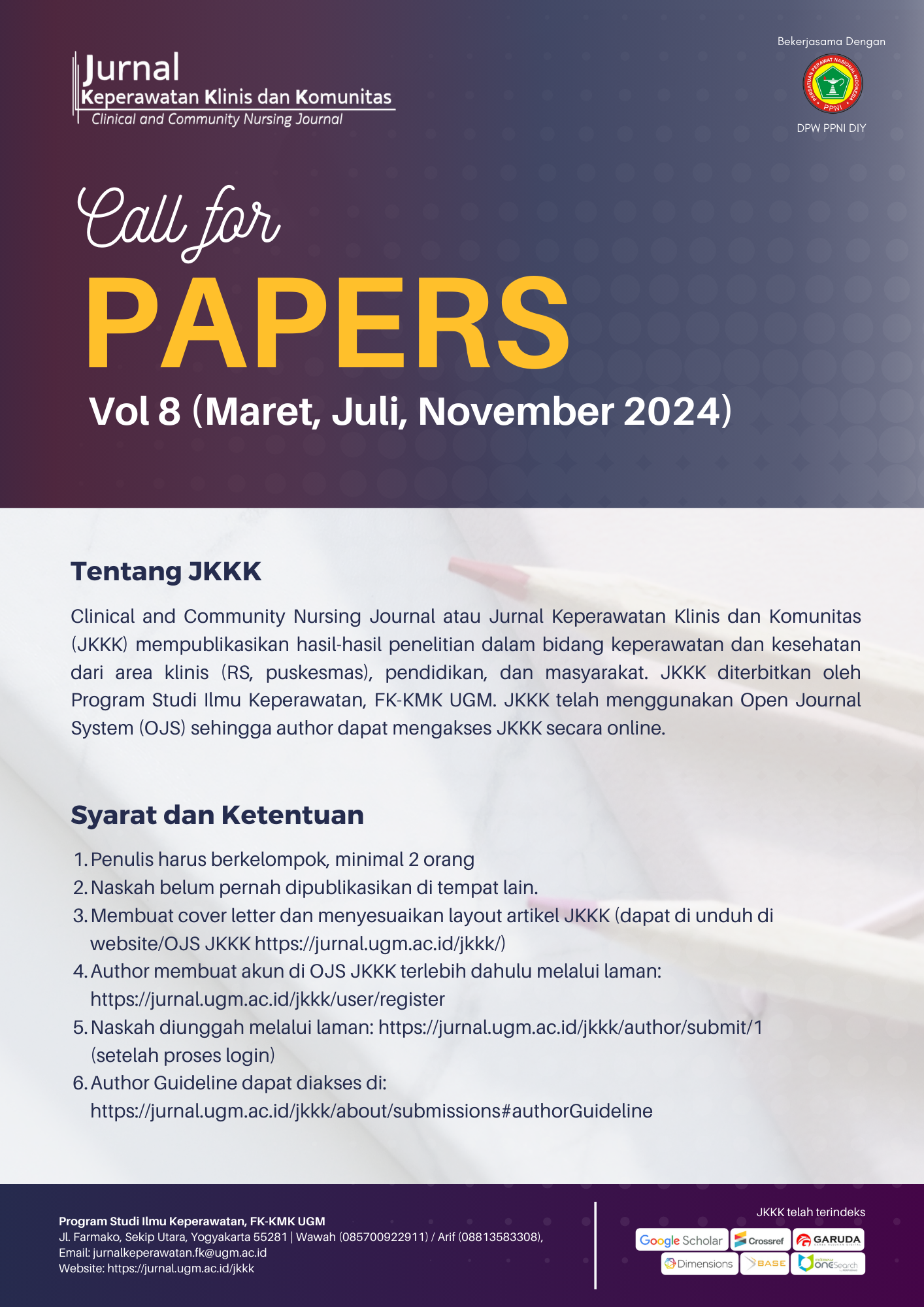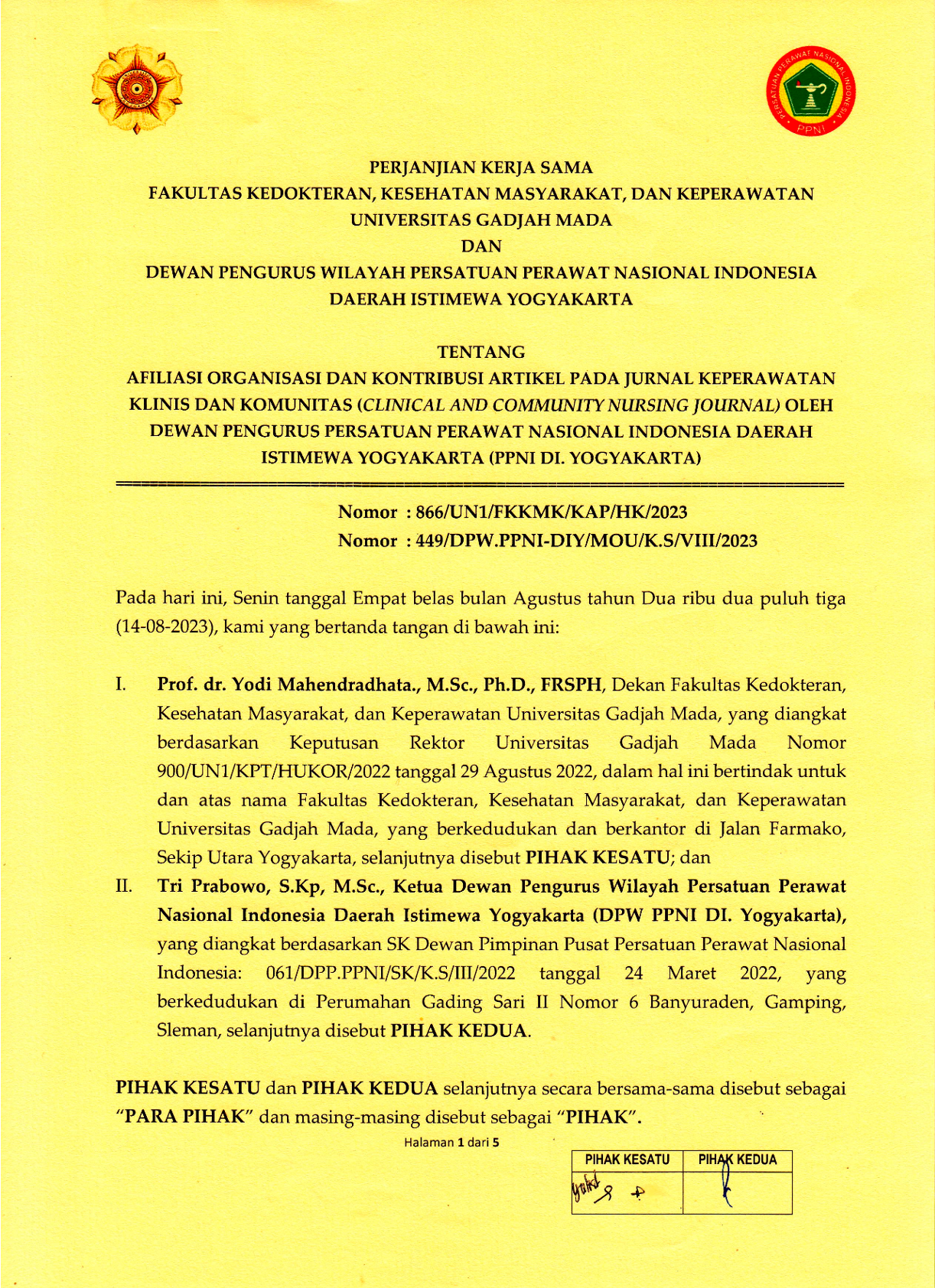Perbandingan Antara Diagnosis yang Sering Ditegakkan dan Possible Diagnosis yang Diprediksikan oleh Perawat Pada Klien dengan Gangguan Jiwa
Intansari Nurjannah(1*), Dewi Retno Pamungkas(2), Sri Warsini(3)
(1) Departemen Keperawatan Jiwa dan Komunitas, Fakultas Kedokteran, Universitas Gadjah Mada, Yogyakarta
(2) Sekolah Tinggi Ilmu Keperawatan Akhmad Yani, Yogyakarta
(3) Departemen Keperawatan Jiwa dan Komunitas, Fakultas Kedokteran, Universitas Gadjah Mada, Yogyakarta
(*) Corresponding Author
Abstract
Background: There is not enough information related to the accuracy of nursing and collaborative diagnoses established by nurses in psychiatric setting in Indonesia.
Objective: The objective of this study was to identify the correspondence between nursing and collaborative diagnoses established and predicted by nurses.
Methods: This was a descriptive cross-sectional study which employed 81 nurse respondents. Data were collected in 2013 using two types of questionnaires. The rst questionnaire was used to identify the most frequent nursing and collaborative diagnoses encountered by the nurses. The second questionnaire was used to identify data which were most frequently identi ed by the nurses. The second questionnaire was developed based on the sequence in the Intan’s Screening Diagnosis Assessment (ISDA).
Results: The results indicated that there were 46 nursing diagnosis labels established by the nurses. Of the 46 nursing diagnosis labels, only 13 (28.26%) corresponded precisely to the labels in North American Nursing Diagnoses Association (NANDA) taxonomy (2012-2014) of nursing diagnoses. As many as 11 diagnoses (23.91%) could be included as key concepts (or diagnostic foci) in NANDA taxonomy. However, these nursing diagnosis labels did not written correctly as in NANDA labels. There were also 22 diagnosis (47%) labels not listed in NANDA taxonomy.
Conclusion: The majority of nursing diagnosis labels did not match with nursing diagnosis labels in NANDA taxonomy.
ABSTRAK
Latar belakang: Belum banyak informasi terkait akurasi diagnosis keperawatan dan kolaboratif yang dibuat perawat dalam setting keperawatan jiwa di Indonesia.
Tujuan: Tujuan dari peneltian ini untuk mengidenti kasi kesesuaian antara diagnosis keperawatan dan kolaboratif yang sudah ditegakkan dan yang diduga oleh perawat. Metode: Penelitian ini menggunakan rancangan cross sectional yang melibatkan 81 responden perawat. Data dikumpulkan pada tahun 2013 menggunakan 2 kuesioner. Kuesioner pertama digunakan untuk mengetahui diagnosis keperawatan dan kolaboratif yang paling sering ditegakkan oleh perawat. Kuesioner kedua digunakan untuk mengidenti kasi data yang paling sering ditemukan oleh perawat. Kuesioner kedua dikembangkan berdasarkan Intan’s Screening Diagnosis Assessment (ISDA).
Hasil: Dari hasil penelitian didapati terdapat 46 label diagnosis keperawatan dibuat oleh perawat. Dari 46 label diagnosis keperawatan hanya 14 label diagnosis (28,26%) yang sesuai dengan label diagnosis berdasarkan taxonomi North American Nursing Diagnoses Association (NANDA) (2012-2014). Sebanyak 11 diagnosis (23,91%) dapat tercakup sebagai konsep penting (atau fokus diagnostik) dalam taksonomi NANDA. Namun label diagnosis keperawatan tersebut tidak dituliskan secara benar sesuai label NANDA. Selain itu ada juga 22 label diagnosis yang dituliskan tidak sesuai taksonomi NANDA.
Kesimpulan: Mayoritas label diagnosis keperawatan yang dituliskan perawat tidak sesuai dengan label diagnosis keperawatan dalam taksonomi NANDA.
Keywords
Full Text:
PDFReferences
Sangat Besar, Beban akibat Gangguan Jiwa. 2001 [cited 2007 25 July]; Available from: http://www.gizi.net/cgi-bin/berita/fullnews.cgi?newsid1002779805,55571.
Nurjannah I, Warsini S, Mills Comparing methods of diagnostic reasoning in nursing. Journal of Nursing and Health Care. 2013; 1(1).
Departement Daftar Rumah Sakit Indonesia. 2007 [cited 2007 27 July]; Available from: http://www.yanmedik-depkes.net/statistik_rs_2007/daftar_rs/menuRS.html.
Wilujani A. Pemahaman Baru, Harapan Baru. 2001 [cited 2007 27 July]; Available from: http://www.tempointeraktif.com/hg/nusa/jawamadura/2005/02/21/brk,20050221-55,id.html.
Carpenito L, J, Nursing Diagnoses Application to Clinical Practice. 13, editor. Lippincot Williams & Wilkins; Philadelphia: 2010.
Nurjannah Proses Keperawatan NANDA, NOC dan NIC (Indonesian language). Mocomedia; Yogyakarta: 2010.
Fitria Rekomendasi Konas Keperawatan Jiwa VII di Bali. 2010 [cited 2012 3 January]; Available from: http://www.fkep.unpad.ac.id/2010/12/rekomendasi-konas-jiwa-bali-4/
Herdman T, H, Kamitsuru NANDA International Nursing Diagnoses: Definition & Classification, 2015-2017. Wiley Blackwell; Oxford: 2014.
Wilkinson J, M. Nursing Process and Critical Thinking. 4rd, editor. Pearson Education; New Jersey: 2007.
Nurjannah I. ISDA Intan’s Screening Diagnoses Assessment. Mocomedia; Yogyakarta: 2010.
McCloskey J, C, Bulechek G, M. Standardizing the language for nursing treatments: an overview of the Nursing Outlook. 1994;42(2):56-63.
Clark D, A language for nursing. Nursing Standard. 1999;13(31):42.
Bulechek G, M, Butcher H, K, Dochterman J, M. Nursing Intervention Classification. fifth, editor. St Louis, Missouri: Mosby Elsevier; 2008.
Herdman T, Diagnosis keperawatan: definisi dan klasifikasi 2012-2014. EGC; Jakarta: 2011.
Paans W, Sermeus W, Neweg R, MB, Krijnen W, P, Cees P Do knowledge, knowledge sources and reasoning skills affect the accuracy of nursing diagnoses? a randomised study. BMC Nursing. 2012;11(1):11-22.
Wong K, S, T, Chung W, Y, Diagnostic reasoning process using patient simulation in different learning environments. Journal of Clinical Nursing. 2002;11:65-72.
Yang H, Thompson C, Bland M. The effect of clinical experience, judgment task difficulty and time pressure on nurses’ confidence calibration in a high fidelity clinical stimulation. BMC Medical Informatics and Decision Making. 2012;12:113.
Nurjannah I, Warsini S, Mills Comparing methods of diagnostic reasoning in nursing.
Article Metrics
Refbacks
- There are currently no refbacks.
Copyright (c) 2017 Intansari Nurjannah, Dewi Retno Pamungkas, Sri Warsini

Jurnal Keperawatan Klinis dan Komunitas (Clinical and Community Nursing Journal)
collaborates with DPW PPNI DIY
![]()
Jurnal Keperawatan Klinis dan Komunitas (Clinical and Community Nursing Journal) is licensed under a Creative Commons Attribution-ShareAlike 4.0 International License.




